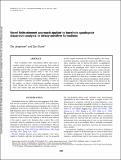Novel finite-element approach applied to borehole quadrupole dispersion analysis in stress-sensitive formations
Author(s)
Jorgensen, Ole; Burns, Daniel R
DownloadJorgenson-2013-Novel finite-element.pdf (2.532Mb)
PUBLISHER_POLICY
Publisher Policy
Article is made available in accordance with the publisher's policy and may be subject to US copyright law. Please refer to the publisher's site for terms of use.
Terms of use
Metadata
Show full item recordAbstract
Near a borehole, stress concentration effects may cause a complex spatial variation of elastic anisotropy. Stress-induced sonic anisotropy results when moduli and velocities are stress dependent and the state of stress is nonhydrostatic. For such cases, the appropriate material model is that of an elastic orthorhombic medium with material axes aligned with the principal axes of stress. We simulate the dispersion characteristics of quadrupole waves propagating along a borehole in a stress-sensitive formation. To include sensitivity to stress in the analysis, we derive a finite-element modeling approach which includes the stress-velocity relationship, the perturbed stress and velocity field near the borehole, and solutions to the full coupled anisotropic and 3D wave equation. We characterized the anisotropy around the borehole for different in situ stress conditions, and we derived the effects on quadrupole dispersion characteristics. Of particular interest was the phase velocity of the quadrupole wave, which at low frequencies provides an estimate of formation shear-wave velocity. Results indicated that the quadrupole mode dispersion was relatively insensitive to the hoop stress effects around a borehole giving greater confidence to shear-wave estimates made from these modes. The proposed ring-element formulation, which includes Fourier expansions of the field variables in the direction of the circumference, is well suited to this analysis and can be adapted to include other effects, such as a finite-length borehole.
Date issued
2013-10Department
Massachusetts Institute of Technology. Department of Earth, Atmospheric, and Planetary SciencesJournal
GEOPHYSICS
Publisher
Society of Exploration Geophysicists
Citation
Jorgensen, Ole, and Dan Burns. “Novel Finite-Element Approach Applied to Borehole Quadrupole Dispersion Analysis in Stress-Sensitive Formations.” GEOPHYSICS 78, no. 6 (October 11, 2013): D499–D509. © 2013 Society of Exploration Geophysicists
Version: Final published version
ISSN
0016-8033
1942-2156